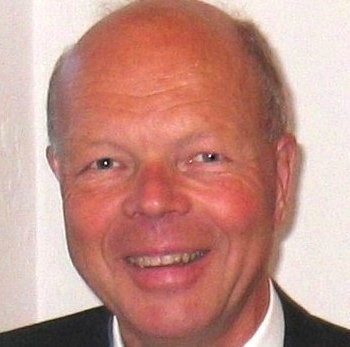Johannes Andersen 
Personal data:
Name: Johannes Andersen
Title: Associate Professor emeritus
Born: 29 August 1943
Email: ja@astro.ku.dk
Fax: +45 3532 5989
Phone: +45 3532 5934
Secretary: +45 3532 5999
Private: +45 5943 8982
Job description:
My job description at the NBI includes research and liaison tasks to promote the scientific
returns of the Danish membership in international astronomical organisations.
For the period 2002-2013, I served as Director of the
Nordic Optical Telescope on La Palma,
Canary Islands, Spain.
A brief formal CV can be found here, and
an (incomplete) publication list here.
Current activities are briefly summarised as follows:
Research projects
Numbers in my publication list are given for
reference.
Following earlier instrumentation projects, I served 1996-2002 as responsible
for the instrument center IJAF (now IDA), which equipped
the Danish
1.5m telescope at ESO and the NOT with
state-of-the-art CCD and near-IR cameras (171, 198, 237, 241).
My main current astronomical research focuses on observational studies
of the chemical and dynamical evolution of the disk of the Milky Way Galaxy.
Following an earlier, detailed spectroscopic study (158), we are currently
analysing new, accurate data on ages, metallicities, and kinematics of
some 10.000 nearby F and G dwarfs (165, 190, 197), including the connection
between their past and present galactic orbits (195). The culminating paper
(279) is now being followed up by a review and verification of the main
calibrations and associated results (328, 346).
As part of this effort,
we have also determined radial velocities for some 25.000 late-type
HIPPARCOS
stars.
In a part of the project devoted to the most metal-poor - hence
presumably oldest - halo stars in the Galaxy, we have been awarded a large
Programme at the ESO Very Large
Telescope and UVES
spectrograph in 2000-2001. A first, interesting result on an age determination
for one of these old stars using radioactive uranium-238 and thorium-232
is published in (244). A series of papers describing the results of the systematic
programme has followed (259, 263, 268, 277, 278, 290, 301, 303, 320, 329,
331, 345, 355, 356, 361).
A second, connected, primary interest for many years is the observational
study of stellar evolution, especially the reliability of stellar ages.
A long program to determine and analyse accurate stellar masses and radii
in eclipsing binaries, summarised in (140, 146, 177, 198, 232 and most
recently in 350). This was supplemented by a study of a few open clusters,
where again sufficiently detailed work led to firm conclusions on the stellar
models - and considerable surprises regarding the dynamical state of these
"standard" clusters (196, 216, 234).
Two sidelines of this research were the
dynamics and binary frequency of globular clusters (67, 186), and a study
of some potentially significant pre-main-sequence binaries (124, 134, 199,
207).
In return for a Danish investment in the French EROS microlensing project
at La Silla, we are sharing in some of the corresponding publications,
e.g. (211, 212, 219, 220, 233, 239) - including the culminating ones (322,
343), which showed that planet- and star-like baryonic objects constitute a
negligible fraction of the dark Galactic halo.
Following an earlier low-level foray into the search for extrasolar planets
(170, 184), I am starting a participation in the ground-based follow-up of transiting extrasolar planets discovered with the NASA Kepler Mission and from ground-based surveys, together with postdoc Lars Buchhave and the exoplanet group at the Harvard-Smithsonian Center for Astrophysics (353, 354, 357).
As part of these projects, I spent the year 1970-71 in Marseille,
1971-72 at the DAO, Victoria, 1986-89 at the Harvard-Smithsonian Center
for Astrophysics, and September-December 2000 at Observatoire de Paris.
Community services
-
Board Chair (2005-2010) for the ERA-NET
ASTRONET, which is preparing a comprehensive plan for the long-term
development of all of European astronomy.
-
Member of the Board, Executive Committee, and Telescope Directors' Forum
of the Integrated Infrastructure Initiative
OPTICON (2000-2012), which
promotes cooperation and coordination in the development and exploitation
of European research infrastructures for (ground-based) optical-infrared
stronomy.
-
Chair of the Danish Astronomy Committee and editor of its latest report
Danish Astronomy 2007-2017.
-
General Secretary of the International Astronomical Union (IAU)
1997-2000.
-
Member of the Council (1997-2000) and Bureau (1998-2002) of
COSPAR.
-
Responsible 1996-2002 for the SNF-funded "instrument centre" IJAF (now IDA),
which coordinated and supported the equipment and scientific use of the
Danish observing facilities abroad, primarily the 1.5m
Danish telescope at ESO and the NOT.
-
Member of the NOT Council 1990-98, Chairman
1995-98 (150, 182). Director 2002-2012.
-
Member of the ESO Scientific Technical
Committee 1992-1997, Chairman 1993-95. Chairman of ESO Working Groups
on future scientific priorities for the La Silla Observatory (161, 169,
185, 187) and on the political aspects of choosing a site for the
European Extremely large Telescope (2006).
-
My past sins also include two periods as Director of the former Astronomical
Observatory of Copenhagen University (1984-86, 1992) and founding member of the
NBI Board (1993-95).
Last updated 25-06-2011 at 14.35 by ja@astro.ku.dk.

